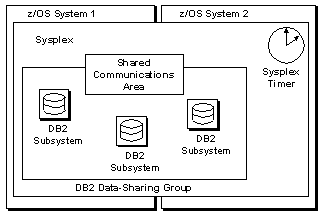DB2 installations can have multiple MVS sysplexes. Each sysplex can contain multiple DB2 data-sharing groups. A DB2 data-sharing group is an MVS Cross-system Coupling Facility (XCF) group.
Each member of a DB2 data-sharing group is a DB2 subsystem, also called a member. The members within a single DB2 data-sharing group can share data. DB2 data sharing does not function across groups. The Sysplex Timer synchronizes timestamps between all DB2 subsystems in a data-sharing group.
The members of a DB2 data-sharing group can reside on the same or different MVS systems. Therefore, a DB2 data-sharing group can either span several MVS systems or reside on a single MVS system.
Each DB2 subsystem maintains its own recovery logs and bootstrap data set (BSDS). The BSDS for every DB2 member in a data-sharing group contains information about the other group members’ BSDSs. The shared communications area (SCA) in the XCF for a given data-sharing group contains information about all BSDSs and all logs for DB2 subsystems within the group.
Figure 1-9: Illustration of data-sharing group components

Each log record header contains a log record sequence number (LRSN). The LRSN is a 6-byte value derived from the Store Clock timestamp. The LRSN is equal to or greater than the timestamp value truncated to 6 bytes. This value also exists in the header page of the tablespace. In the data-sharing environment, the LRSN replaces the relative byte address (RBA), although each subsystem continues to use the RBA for its own logs and BSDS.